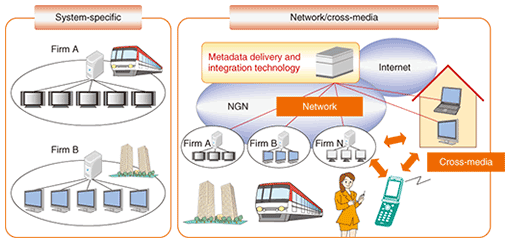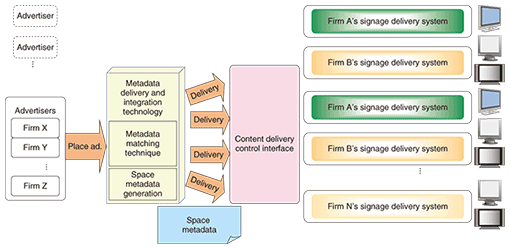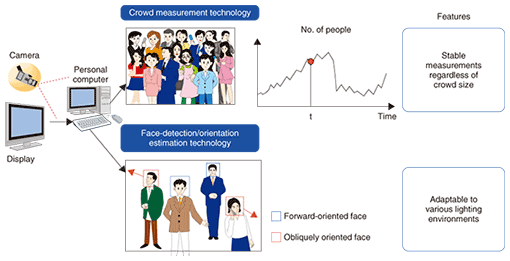 |
|||||||
|
|
|||||||
|
Special Feature: NGN Focus Vol. 8, No. 10, pp. 1–4, Oct. 2010. https://doi.org/10.53829/ntr201010sf1 NTT Group°«s Approach to Digital SignageAbstractNetwork-based digital signage via the Next Generation Network (NGN) is not just a means of providing a new type of information-display terminal—its spread throughout society will make it a next-generation social infrastructure for providing information and creating value. This article introduces the technologies that will be needed to construct this new social infrastructure.
1. IntroductionThere are great expectations for digital signage (electronic signs and posters) as a new advertising medium. The NTT Group itself ranks digital signage as a killer application for the Next Generation Network (NGN). As shown in Fig. 1, digital signage can be broadly divided into two types: system-specific and network/cross-media. In the system-specific type, firms operate systems with different specifications by different methods. In the network/cross-media type, on the other hand, systems installed in various place are networked and advertisements are distributed to them in a synchronized manner.
The system-specific type is the most common at present, but NTT is promoting the spread of the network/cross-media type with the aim of expanding NGN use and uncovering new sources of business revenue. Network/cross-media digital signage can target not only displays set up in large commercial complexes, transportation systems, and retail establishments but also various types of user displays such as digital photo frames in homes and mobile phones, personal computers, and Internet protocol television (IPTV) receivers, which are growing in popularity. In other words, digital signage as envisioned by NTT will become a social infrastructure for next-generation information provision that goes beyond the framework of out-of-home (OOH) media. To this end, NTT is developing metadata delivery and integration technology [1] for networking digital signage and technology for measuring the effectiveness of advertising [2] while also researching and developing cross-media schemes. 2. Metadata delivery and integration technology and advertising-effectiveness measurement technologyMetadata delivery and integration technology enables the integration of digital signs set up at various locations to form a network of signs and integrates and manages content delivery on that network (Fig. 2). This technology can network signage from different vendors on the basis of a content delivery control interface, which is specified by following Digital Signage Systems Guideline 1.0 established by the Digital Signage Consortium. It also manages the attributes of advertising content and signage location and achieves effective media planning through a metadata matching technique that enables the optimal selection of signage locations and display times for specific advertising content.
Furthermore, as there is still no standard index for objectively representing the effectiveness of this kind of advertising, NTT has developed two key technologies: crowd measurement technology for estimating the number of people gathered at an advertising location by subjecting camera footage to image processing and face-detection/orientation estimation technology for detecting areas of a camera image occupied by human faces and determining the orientation of those faces to estimate the number of people facing the digital signage (Fig. 3).
To evaluate the feasibility and effectiveness of these technologies, NTT conducted field trials in November 2008. The results of these trials revealed that the networking of digital signage produced a bigger advertising effect than conventional signage and improved the efficiency of signage through effective media planning and that the technologies developed for integrating and managing the digital signage systems of multiple vendors and for uniformly delivering advertising content worked effectively. 3. Cross-media R&DEfforts are being made to link digital signage and mobile phones and achieve a cross-media system. NTT Laboratories and NTT DOCOMO R&D Center have performed joint experiments on interactive digital signage and have constructed a prototype system. This system was presented at Digital Signage Japan 2009 held in June 2009 to promote the concepts of digital signage that can talk with mobile phones and digital signage that can read the situation. Digital signage that can talk with mobile phones is achieved by linking NTT°«s watermarking technology for video on camera-equipped mobile phones with NTT DOCOMO°«s Recommender technology. The Recommender system chooses ad images and presentation videos that are relevant to each person°«s characteristics, preferences, and behaviors on the basis of his or her mobile Web browsing history. In this system, a watermark embedded in a video can be detected in real time by a camera-equipped mobile phone, and the watermark is transformed into a URL (uniform resource locator) in the resolution server on the basis of the user°«s history; suitable content is then displayed on the mobile phone. Digital signage that can read the situation is achieved by linking NTT°«s SpotAd technology with NTT DOCOMO°«s Recommender technology. Spot-Ad captures the position and movements of people in front of the video display with the camera sensor and instantly presents timely ads on the basis of the physical conditions. Interactive digital signage based on both these technologies will effectively present relevant ads according to each person°«s unique profile. Combining digital signage and mobile phones in this way should lead to personal-media usage scenarios in addition to mass-media applications. 4. Future activitiesAs part of its efforts to promote the networking of digital signage, the NTT Group introduced Hikari Signage in February 2010 as a solution brand for digital signage together with a lineup of solution packages. This packaging of solutions was achieved with the help of NTT IT Corporation, and sales of these packages via business companies in the NTT Group have begun. The digital-signage servers used to drive this series of Hikari Signage solutions have a common interface that can connect to a digital-signage ad platform. As the use of Hikari Signage spreads, the networking of digital signage can be expected to provide new value as a new medium. Looking to the future, NTT aims to expand the penetration of digital signage. It will also study the addition of new solutions to the Hikari Signage lineup and the development of new functions for the digital-signage ad platform to meet the needs of individual Group companies and market analysis results. References
|
|||||||











